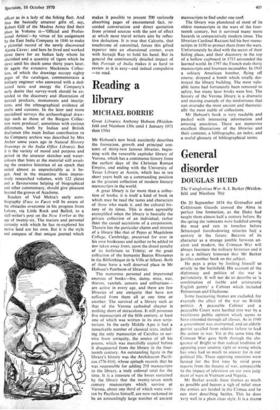Pictures of India
FRANCIS WATSON
British Drawings in the India Office Library Mildred Archer (HMSO 2 vols 70s each) Portrait of India Ved Mehta. (Weidenfeld and Nicolson 70s) Cannibalism is happily rare among Royal Academicians. The only reported instance is the grisly adventure in which John Zof- fany, who set the still charm of the conver- sation-piece upon Nawab and Nabob in eighteenth-century Lucknow, was involved by shipwreck on the Andamans at the start
of his homeward voyage. In the span of two centuries covered by the vast and varied
collection of British drawings in the (former) India Office Library, life was often as cheap as experience was rich. But everything, even the relatively scant illustration of military action, is embalmed for us in the serenity of the absorbed recorder. For the most part this is India without the glory, for even in embassies to a Chinese, a Burmese or an Ethiopian court an artist's business was more with butterflies and plants, temples and tex-
tile designs, than with pomp and protocol.
It is certainly India without the boredom, without the solemnity of purpose that just happened to come in with the camera. It is the India of that 'guiltless spoliation' on which the Daniell brothers travelled so far and so boldly for the limpid aquatints of their Oriental Scenery.
But it must be said quickly that there is nothing from Zoffany's hand to be found here, and only one sketch by Hodges. There
are three by Chinnery, with a number of others plausibly attributed to him. From the esteemed Edward Lear, whose engag-
ingly recorded Indian tour of 1873-5 was sponsored by the Viceroy, Lord Northbrook.
there is a single Banaras view. For the fact
is that among nearly 11,000 drawings and watercolours the Library has a mere 764
(and more than half of them by the Dan- jells) which can be properly called the work of professional artists. In her thoughtful
introduction to the catalogue Mrs Archer categorises these professionals as 'the in- dustrious visitor' (bringing us down to the Illustrated London News coverage of the
1902 Delhi Durbar); 'the hardy resident'. with Chinnery as king; and 'the stay-at-
home', a rather surprising nineteenth-century type (which included Cotman, Cox and Turner) engaged to translate the travelled amateur's efforts before engraving them for publication.
An amateur of the admired and prolific competence of Sir Charles D'Oyly, how-
ever, could father without intervention a dozen illustrated books—birds and sports and topography and antiquities as well as Tom Raw the Griffin—in such near-sinecure appointments as Opium Agent and Commer- cial Resident at Patna, where in the 18205 he had his own lithographic press. And a generation later the Nilgiri hill-station of Ootacamund is vividly established in the Sunday-painterish style of Captain G. 11. Bellasis, which any working-up for repro- duction would have ruined. For the 'amateur artists' who fill the first volume of this splendid catalogue are such by cultivated choice rather than by grading of talent. Ranging from bandsmen and country-born adventurers to bishops, proconsuls and vice- regal families, they testify to an age in which a measure of artistic training and equipment was as natural in an artillerY
officer as in a lady of the fishing fleet. And thus the basically amateur gifts of, say, Robert Gill of the Madras Army find their place in Volume ii—'Official and Profes- sional Artists'—by virtue of his assignment by the East India Company in 1846 to make a pictorial record of the newly discovered Ajanta Caves: and here he lived and worked alone (save for an Indian lady whom he cherished and a quantity of tigers which he slew) until his death some thirty years later. Or again the extensive Mackenzie Collec- tion, of which the drawings occupy eighty pages of the catalogue, commemorates a military engineer who answered with a ded- icated taste and energy the Company's early desire that survey-work should be ex- tended to the discovery and illustration of natural products, monuments and inscrip- tions, and the ethnographical evidence of crafts and customs. In the later and more specialised surveys the archaeological draw- ings such as those of the Burgess Collec- tion were produced, sometimes with curious differences, both by Indian and British draftsmen (the main Indian contribution to the Company archive was described by Mrs Archer some years ago in Natural History Drawings in the India Office Library). But it is the variety of mood and purpose and period in the amateur sketches and water- colours that hints at the material still await- ing the creative historian of an epoch that ended almost as unpredictably as it be- gan. And in the meantime these impres- sively researched volumes, with 122 plates and a flavoursome helping of biographical and other commentary, should give pleasure beyond the groves of Academe.
Readers of Ved Mehta's early auto- biography (Face to Face) will be aware of the obstacles overcome in his progress from Lahore, via Little Rock and Balliol, to a staff-writer's post on the New Yorker at the age of twenty-six. The mature and personal curiosity with which he has re-explored his native land are his own. But it is the style and compass of that unique journal which
makes it possible to present 500 variously absorbing pages of encountered fact, re- corded conversation and direct quotation from printed sources with the sort of effect at which most travel writers aim by reflec- tive deduction. It is true that Calcutta, that touchstone of committal, forces this gifted reporter into an obsessional corner, even with Satyajit Ray to hold his hand. But in general the continuously detailed impact of this Portrait of India makes it as hard to review as it is easy—and indeed compulsive —to read.







































 Previous page
Previous page